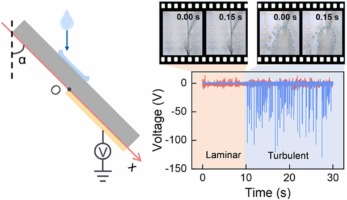Abstract:
Droplets energy harvesters(DEHs) have attracted tremendous attention and shown great potential in harvesting energy from falling water. Current approaches to enhance the device output through adapting a top-electrode in direct contact with the droplets face the drawbacks of fixed droplet-imping-location and inevitable electrode corrosion. Herein, we proposed an easy but effective way to boost the performance of bottom-electrode DEHs through adapting a partial-electrode configuration. It was found that droplets impinging at the boundary between a blank region and the electrode region, instead of at the electrode region, could improve the output peak voltage and current by more than one order of magnitude, up to 30 V. The mechanism is contributed to that water across the boundary bridges the blank and the electrode region for notable inter-region charge transfer, leading to an enhanced electrostatic induction. The induced peak current is proven to be proportional to the changing rate of droplet area on top of the electrode upon initial overlap, and inversely proportional to the thickness of the polymer film in our test range. Based on these findings, DEH with a branched electrode is designed to harvest energy from falling droplets of random positions, as well as energy from turbulent flow of time-variant shapes with an output voltage up to one hundred volts.

Link: https://doi.org/10.1016/j.nanoen.2022.107024
--校内链接--
--校外链接--

微信公众号